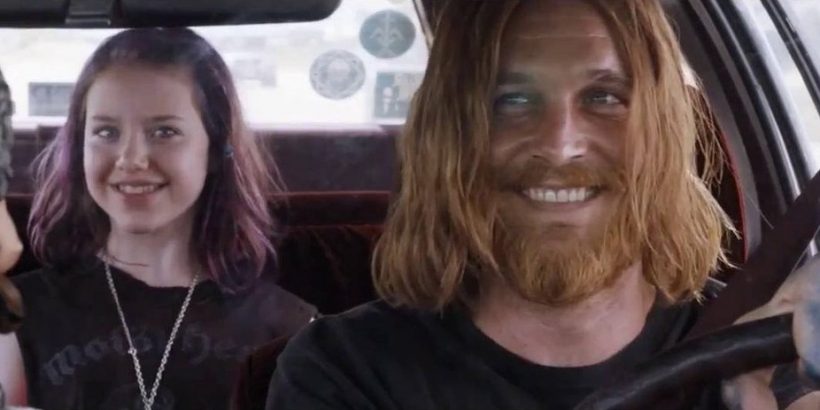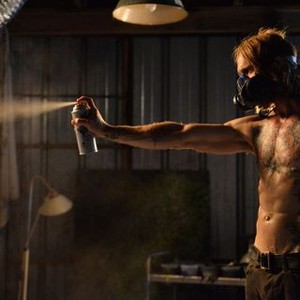Whiskey Review: Still Austin Bottled in Bond High Rye Bourbon
Film Review: The Devil’s Candy (2015)
There was a moment I had the impulse to pair my tasting of Still Austin Bottled in Bond High Rye with a film so on the nose when thinking about Texas-based horror that the review would just write itself. Then I paused, took a sip, and decided to pivot to a film that became an instant classic in my world, especially given my intense appreciation for a killer soundtrack, art-based horror, and a sweaty and tattooed Ethan Embry.
Sean Byrne first jumped onto my radar with his masterful Australian psychological slasher The Loved Ones (2009), a film that played with a twisted father-daughter relationship and offered one of my favorite feminine baddies in Lola Stone (Robin McLeavy). Byrne chose to offer a different perspective with The Devil’s Candy, creating a beautifully connected and mature family unit with metal-head artist dad Jesse (Embry, Cheap Thrills), mom Astrid (Shiri Appleby, Swimfan), and old soul 13-year-old Zooey (Kiara Glasco). The film follows the Hellman family as they move into a gorgeous and suspiciously cheap Austin farmhouse, only to be almost immediately beset upon (and subsequently terrorized) by a sympathetic but stricken Ray (a brilliant Pruitt Taylor Vince) determined to return to his home.

The Devil’s Candy has the heart of 70s horror, and a grit and grunge that feels original to Byrne’s vision. There’s a strong Satanic Panic vibe, as Ray is forced to drown out the droning voice of a demonic entity with his cherry red Flying V while staring at a hanging crucifix, and throughout the film there’s similar religious imagery and thematic implications that the family is facing a particularly deviant demonic force – one that needs “candy” – youngsters delivered by Ray to satisfy His insatiable sweet tooth. The family at the center of the chaos stand out from some other genre films with a similar tone, as Jesse and Zooey especially are so well-developed on a deeper level and come through as truly bonded against a world that doesn’t understand them even before supernatural elements are introduced.
Ethan Embry embodies Jesse as a passionate and slightly put-upon artist, as most seem to be, who sees the move to the farmhouse – and its enviable barn/artist studio – as an opportunity to finally provide for his family in a way that hadn’t up to then presented itself. He feels the weight of the role the world expects him to play as a husband and father, while tussling with the desire to find success in his passion. While he is forced to paint murals of butterflies for a bank, even Zooey seeing his self-betrayal, but he’ll do it and others if it means that he and Astrid can own the home they never thought they’d be able to buy. His tug-of-war is on display as he swears to Astrid that he’ll take any shit gig that comes to him, while she bemoans the extra commute time for her between the new house and the hair salon she works at. This struggle is so incredibly familiar and relatable, making it even more heartbreaking when, no sooner do they move in and get comfortable, Ray shows up at the doorstep begging to “come home.”
There is some ambiguity as to whether we’re dealing with a demonically powered house, man, or men, as Jesse immediately becomes entranced and, ultimately inspired, by the same droning voice that powers Ray, but as Astrid and Zooey don’t seem to hear the voice, this appears to be more of an Amityville situation than anything. There’s a certain appeal to the masculine being overtaken by evil, though it does seem the simpler target, and in The Devil’s Candy the simplicity of the possession works in its favor. As a viewer I don’t crave an explanation, I accept that this demon, from wherever it has spawned, finds its home in the minds of men and plants its seeds there. For Ray’s part, he has been struggling with “Him” since childhood, plagued with the task of delivering children, the Devil’s “candy.”

Byrne films Embry in what some could describe as a “male gaze,” with lingering shots of his tattooed, sweat-laced back and torso, his chiseled arms as he brandishes his spray paint cans as a kind of weapon, and soaked metal-head tees. As a long-time fan of Embry, I appreciate this from my own gaze, but I also think it’s an interesting choice that serves the film well. Horror is so often accused of objectifying women’s bodies with no more reason than…well…boobs, but Byrne chooses to linger on the image of a man’s body at its stereotypical peak, while at the same time relentlessly leaving Jesse powerless and, some might say, emasculated, with the lack of control he has over what is happening to his family.
As Ray’s (and subsequently the “Devil’s) attention is drawn to young Zooey, Jesse is repeatedly distracted by the carrot of inspiration provided to him by the melodic voice in his head. At the same moment he’s under a trance that generates the best, and darkest, art instillation he’s ever created, Zooey is left alone and vulnerable after the first day of school. This leads to a frantic apology and a promise on Zooey’s life that he’ll never forget her again; a promise that it seems the universe itself is determined to break. After some seriously trauma-filled moments, when Zooey needs her dad the most, Jesse is relegated to a helpless bystander, captive to the whims of the demon that desires his “sweetest candy.” It starts to feel that Ray is working harder than Jesse is to protect Zooey from falling victim, creating a compelling storyline that escalates to an insanely satisfying, if not slightly droll, finale.
Let’s transition a bit, shall we? I would confidently say The Devil’s Candy is to possession horror what Still Austin Bottled in Bond High Rye Bourbon is to…well…bourbon. There’s an expectation with both genres (when categorizing whiskeys as genres), the promise of a premise, that, if unmet, brings about suspicion and doubt. Some viewers of The Devil’s Candy may be left wanting an explanation, a map or formula that they expect of their possession horror, but I don’t ask for that. What I ask for in this kind of horror film is passion, guts, and a killer soundtrack and score (thanks to Michael Yezerski). And I can say the same is true for what I look for in a good bourbon. I want originality, I want something I haven’t tried before, something that tastes like passion and guts.

Still Austin is a grain-to-glass whiskey company, and it’s the first distillery of its time to open in Austin, Texas since the end of Prohibition. Their mission is to utilize Texas-grown resources, working with local farmers who focus on conservation, sustainability, and energy efficiency to source their hand-crafted grains. The Still Austin Bottled in Bond High Rye Bourbon is the fall release of the seasonal featured whiskeys in the Bottled in Bond series, with a beautiful label showing the artwork of native Texan Marc Burckhardt that pays homage to the Texas terroir. The bourbon has a mash bill of 70% White Corn, 25% Rye, and 5% Malted Barley.
For those interested, the Bottled in Bond act was originally established in 1897 and is used to guarantee the highest quality and authenticity. For a whiskey to qualify for this regulatory label it must abide by four specific rules – the whiskey must be the product of one distillation season by a single distiller at a single distillery, aged in a federally bonded warehouse under U.S. government supervision, aged for at least four years, and bottled at 100 Proof (50% ABV).
Still Austin is a bourbon that will appeal to those of you who enjoy a powerful and perfectly balanced whiskey that celebrates the Lone Star state by nurturing locally beneficial collaborations.
Film Rating: The Devil’s Candy 💀💀💀💀/5
Tasting Notes: Still Austin Bottled in Bond High Rye Bourbon
Aesthetic: The bourbon is a rich, caramel color.
Nose: There’s a delightful and airy citrus element that presents at the first sniff. Once open, I enjoyed elements of white sesame, marbled rye, and cherry compote.
Palate: Woosh! The bourbon gets straight to the point – a steady, pleasant heat that washes the palate, a kind of wasabi heat, quick at the onset that disperses nicely. Then I began to parse out notes of honeycomb, bittersweet chocolate, nuttiness like from a cashew, as well as some fruity notes, a pomegranate burst of flavor. The whiskey has a buttery mouthfeel and a medium finish with a perfectly formed nip of bitterness that cuts the sweet.
Whiskey Rating: 🥃🥃🥃🥃/5

